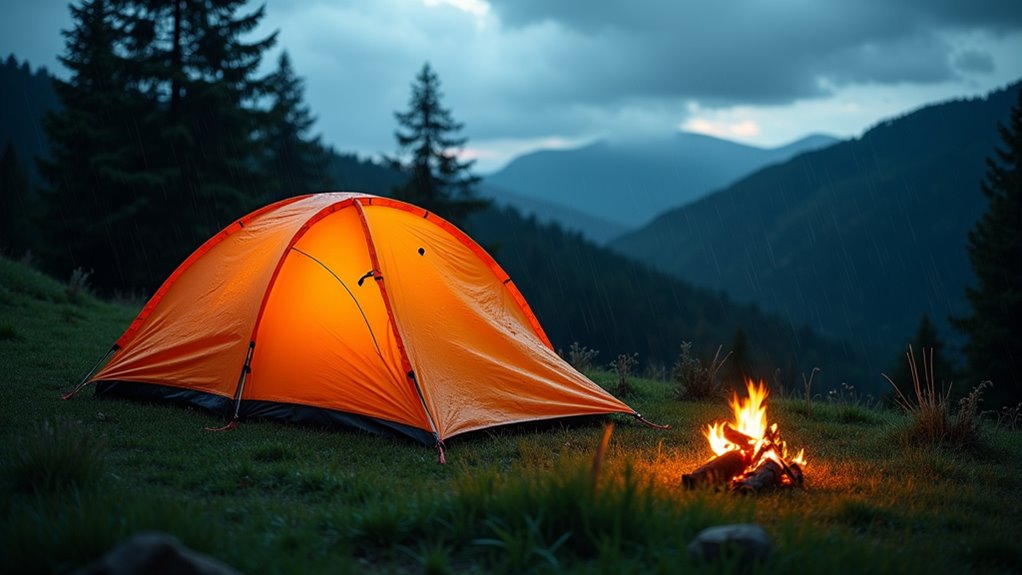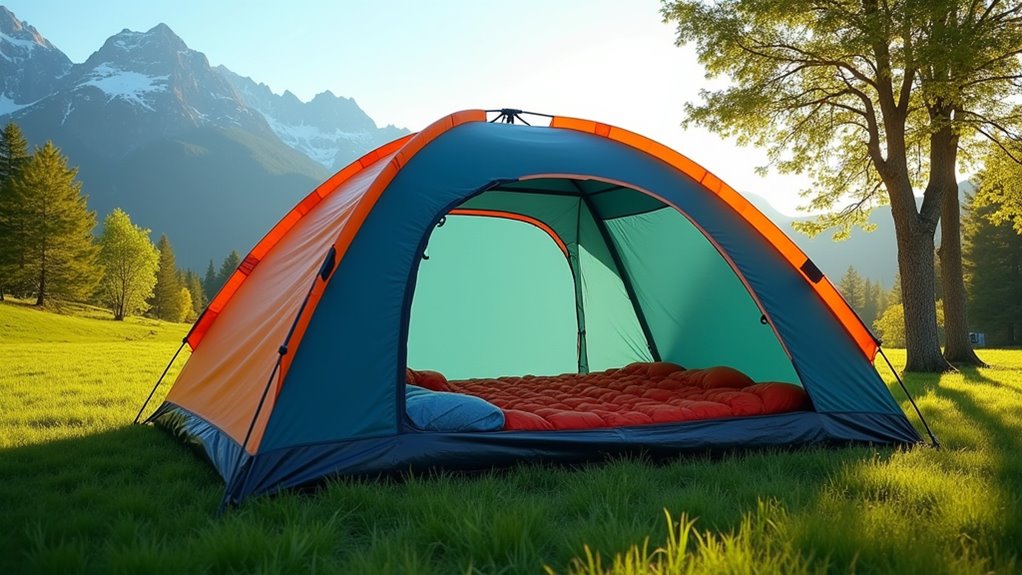Are Inflatable Tents Any Good
This post contains affiliate links. As an Amazon Associate, we earn from qualifying purchases.
Inflatable tents are a reliable and convenient option for camping, known for their quick setup and strong weather resistance. They inflate easily with a pump and use high-pressure air beams for stability. Made from durable materials like polyurethane, these tents can handle harsh conditions while offering spacious interiors, high ceilings, and good ventilation for comfort. Although they usually cost about 20% more than traditional tents, their ease of use and durability often make them worth the investment. Further details and features to consider will be discussed later in the article.
Essential Facts in 30 Seconds
- Inflatable tents set up quickly with a pump, needing less assembly than pole tents.
- They provide strong stability and resist harsh weather like wind and rain.
- Interiors are spacious with high ceilings for comfort and flexibility.
- Made of durable materials that require maintenance but offer long-lasting use.
- Typically cost about 20% more than traditional tents, but ease of use and durability offer value.
Setup and Convenience
Set up an inflatable tent by following clear steps for ease and speed.
Pick a flat spot without sharp stones or trash. This keeps your tent strong for many uses. Clear the ground well. Lay a footprint to stop moisture from seeping in.
Spread the tent out carefully in a large area. Check the frame for bends or twists. Find the valves and attach the pump firmly, so no air escapes. Pump air slowly and watch the shape grow firm. Ensure the tent is balanced and stable to provide a secure structure.
Once full, fix the tent to the ground with stakes. Tighten the guy lines for extra hold.
This careful way saves time and makes camping easy. Enjoy your trip with no stress.
Stability and Weather Resistance

Inflatable tents must resist wind well and keep water out. Strong tents use thick layers of materials like polyurethane or PVC. These materials block rain and stop sun damage.
Good tents stay stable in storms and protect you from harsh weather. Knowing these facts helps you pick the best inflatable tent for your trips.
Wind Resistance Features
Inflatable tents stand strong in windy weather thanks to smart design. Their aerodynamic shape lets wind flow smoothly, cutting down resistance.
High-pressure air beams, pumped up to 6-8 bars, keep the tent stable but flexible. These beams bend with the wind instead of breaking.
Steel pins or heavy sandbags anchor the tent firmly to the ground. Guy ropes and tension points stop the tent from lifting or moving sideways.
Most tents have 16 to 22 anchoring points for extra security. Set up right, these tents can resist winds up to 100 km/h. This keeps you safe and comfortable inside.
Weatherproof Materials Used
Inflatable tents use strong weatherproof materials to stay stable and protect you from rain and wind. Many tents have coatings made of polyurethane or silicone. These coatings stop water from soaking through.
Polyester and nylon fabrics are popular because they keep water out when treated. Polycotton blends work well, too. They let air pass and dry quickly, making the tent comfortable in different weather.
Groundsheet materials like PE resist wear and keep moisture out. Tents have fully taped seams that block water from entering at the joints.
Check the hydrostatic head rating to find out how waterproof a tent is. Ratings above 1500 mm HH mean the tent will keep you dry in heavy rain.
Space and Comfort

Inflatable tents offer roomy interiors for easy movement and fun activities.
Good ventilation comes from many windows and mesh panels, keeping air fresh inside.
Models like the Outwell Colorado 5 Air have separate rooms for privacy.
Families enjoy more comfort and better organization during camping trips.
Spacious design makes camping feel like home.
Maximized Interior Space
Maximizing interior space in inflatable tents makes camping much better. Many tents offer over 100 square feet of space.
Ceilings reach about 7 feet tall. This height lets you stand and move freely inside. Open floor plans allow easy arrangement of air mattresses, chairs, and tables.
Family tents often include zippered partitions for privacy. These tents work well for groups and families. The open space adapts to many activities.
This design improves comfort and enjoyment during camping trips.
Enhanced Ventilation Features
Effective ventilation makes camping tents more comfortable and less damp. Inflatable tents use dual-level vents to let warm air out and fresh air in.
Mesh panels on tent walls keep air moving, stopping humidity and mold. You can open or close mesh doors from inside, so you stay dry in bad weather.
Overhead and draft vents help air flow and keep you comfortable. Good ventilation keeps tents dry and fresh for better camping trips.
Multi-Room Configurations
Multi-room inflatable tents fit families or groups of 4 to 14+ people. You can change room layouts to make bigger open spaces.
The main living area links to separate sleeping rooms. This setup keeps noise low and privacy high for better sleep.
Air-beam technology holds the tent up without heavy poles. This gives you more space and comfort inside.
These tents often cover over 20 square meters and have plenty of headroom. Some have vestibules for covered outdoor space without losing inside room.
Multi-room tents offer flexible space and a comfy camping experience for all.
Durability and Maintenance
Inflatable tents combine convenience and innovation. Knowing their durability and how to maintain them ensures a great camping trip. High-quality tents use polyester or nylon with many layers. These fabrics stop holes and keep water and wind out. Pick a tent that fits your usual camping spots, not extreme weather. Tents made from waterproof materials often perform better during unexpected rain.
Clean your tent after every use. Remove dirt and wipe the fabric dry. Store it in a cool, dry place to stop mold growth. Always carry a repair kit for quick fixes. Small holes happen but repair easily. Proper tent maintenance is crucial for ensuring longevity and waterproof capabilities.
Secure your tent well when setting it up. This lowers stress on its structure. Follow these tips, and your tent will last for many trips. It will keep you safe and dry on all adventures.
Cost and Value
Inflatable tents cost about 20% more than traditional pole tents on average.
Entry-level inflatable tents start at prices close to mid-range conventional tents. For example, the Pavillo Sierra Ridge 4 costs around £311 and offers good value.
The RBM Outdoors Panda Air Large gives more space at roughly $12.16 per square foot, making it a smart buy.
Discounted models like the Berghaus Air 400 Nightfall can lower your spending.
The higher upfront price pays off with less damage to poles and easier setup.
Comparing prices carefully helps you find the best tent for your budget and needs.
Limitations and Considerations
Inflatable tents bring easy setup and less pole damage. They also have limits. Thin materials make them easy to puncture. Sharp objects can cause damage. Pick your camping spot carefully.
You need a pump to inflate the tent. No pump means no tent setup. Electric pumps work fast but need power. Power isn’t always near in wild places. Carry a backup pump to stay safe.
These tents weigh more than pole tents. They take up more space in your bag. This affects packing, especially for light gear. Think about these points before you buy. Match them with your camping needs.
Frequently Asked Questions
How Do Inflatable Tents Compare to Traditional Tents for Long-Term Camping?
Inflatable tents set up fast and offer lots of room inside. Families enjoy the comfort these tents provide. Traditional tents stand strong in tough weather and last many seasons. Data shows traditional tents resist wind and rain better. Inflatable tents work well for short trips but may wear out quicker. For long camping trips, durability matters most. Traditional tents often use heavy-duty materials. Inflatable tents use air tubes, which can puncture easily. Think about your camping needs before choosing. Comfort or toughness? Both have their place.
Can Inflatable Tents Withstand Extreme Weather Conditions Like Snow or Hail?
Inflatable tents can handle tough weather like snow and hail. Strong materials and good design help them stay safe. You must anchor them well to stop movement in storms. Some tents resist wind up to 50 mph and shed snow easily. Heavy hail might cause small dents but rarely breaks the tent. Check product ratings for weather strength before buying. They work best in mild to moderate storms, not severe weather. Stay alert and take down tents in extreme conditions for safety.
Are Inflatable Tents Suitable for Solo Backpacking Trips?
Inflatable tents work well for solo backpacking trips. They weigh less than many traditional tents. Setting them up takes just a few minutes. These tents offer enough room to sleep and store gear comfortably. They keep you dry during rain. Watch out for strong winds, though. Inflatable tents do not hold up well in bad weather like heavy wind. Many hikers find them easier to carry and faster to use. This makes your trip simpler and more fun.
What Accessories Enhance the Functionality of Inflatable Tents?
Electric pumps speed up tent setup and save your energy. Sidewall poles add strong support, keeping the tent steady in wind. Hanging organizers and outside pockets help you store gear neatly. These accessories make camping easier and your space tidy. Use them to enjoy a smooth, stress-free camping trip.
How Do I Properly Clean and Maintain an Inflatable Tent?
Keep your inflatable tent clean by using mild soap and water. Use a soft cloth or sponge to gently wash the surface. Avoid harsh chemicals or rough scrubbing to prevent damage. Check the tent regularly for holes or weak spots. Patch any small tears quickly to stop leaks. Make sure the tent dries completely before folding and storing. Store it in a cool, dry place away from direct sunlight. Doing these steps helps your tent last longer and stay strong.
Conclusion
Inflatable tents offer a great mix of comfort and ease for campers. Models like the Heimplanet Cave and Zempire Aerobase set up in minutes and hold up well against rain and wind. They weigh less than many traditional tents, making them easy to carry. These tents work best in mild to moderate weather. They may not resist strong storms or heavy snow very well. Some users mention concerns about punctures or wear over time. Still, their fast setup and cozy space make camping simpler and more fun. Think about your camping style and weather before buying. This way, you get a tent that fits your needs perfectly.
